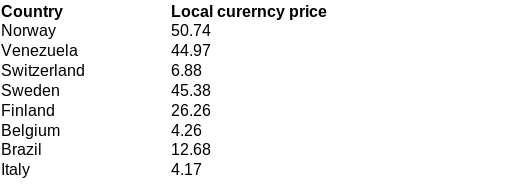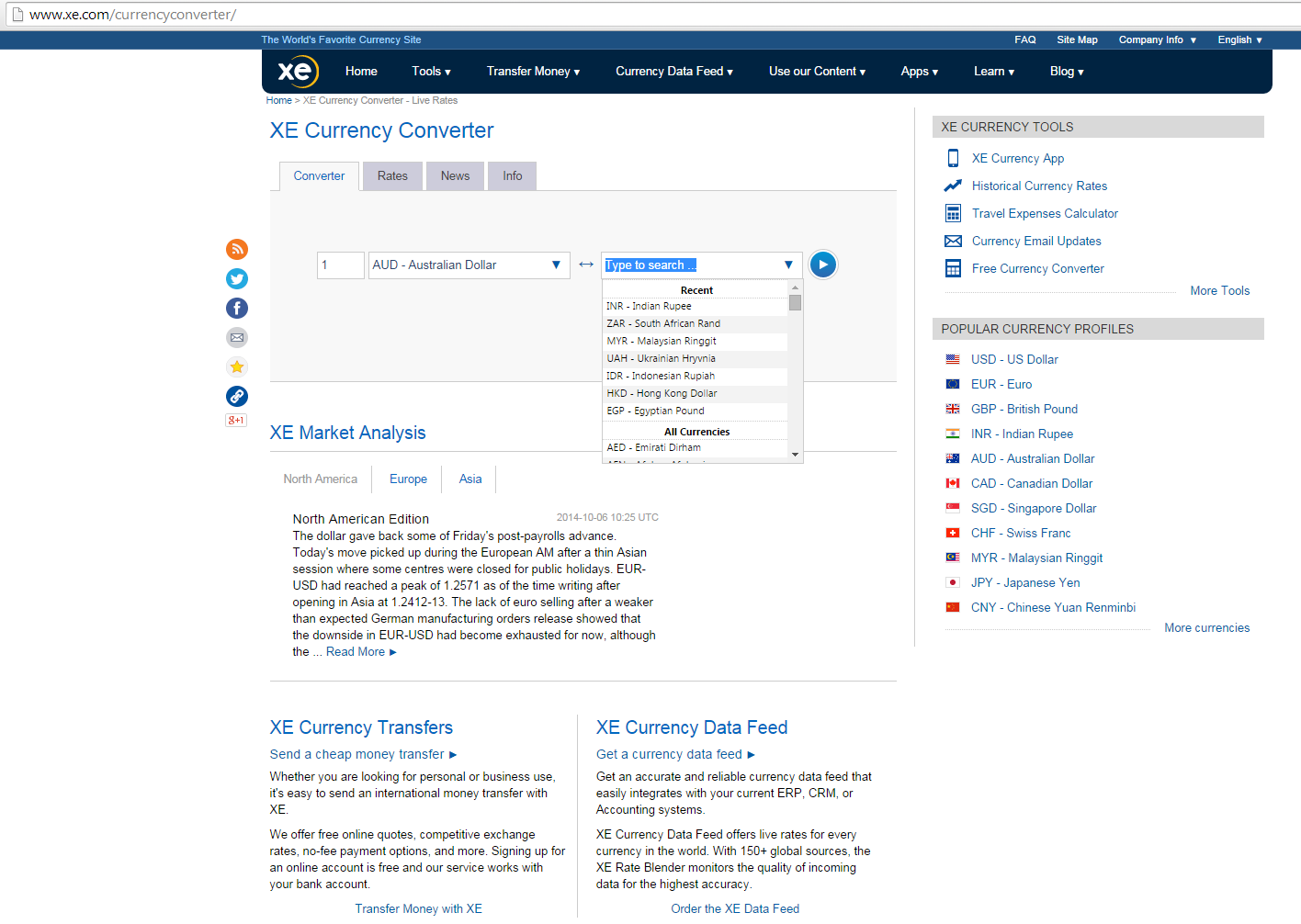Big Mac Prices from All over the World: Minor Discrepancies
Despite the fact that a lot of people view a clear connection between McDonald’s and the current economic state of the U.S., the assumption that the McDonald’s fast food affects the economy of the United States is wrong – instead, McDonald’s has a direct influence on the global economy. In fact, the Big Mac index has been invented in order to evaluate the currency rates at a specific point in time (Gillespie, 2014). The table below displays the current prices for a Big Mac in the world’s major states:
Table 1. Big Mac Prices in January 2014, by Country(The Statistics Portal, 2014; XE currency converter, 2014)


Price Analysis: What Explains Difference in Financial Policies
The difference in the prices listed above obvious; however, the reasons for such discrepancies are not. In order to research the issues underlying the concept of the purchasing power parity (PPP). According of the latter, the price of the product in question in a specific state must be equal to that in the U.S. with the adjustment of the exchange rate (Morse, 2013).
However, a closer look at the way, in which prices for fast food in general and McDonald’s hamburgers in particular are set in various states, one will discover that the process of setting the price for a Big Mac depends greatly on the GDP per person in the chosen area; in fact, the price for the product is in a direct proportion to the GDP per person. In other words, the lower the household income for a specific person of family is, the lower the price or a Big Mac is.
Indeed, a closer look at the table will reveal that the highest prices for Big Macs are set in the states with the greatest GDP per person, including Sweden, Norway, Switzerland, Venezuela, etc., whereas the countries with the smallest GDP suggest the smallest prices for the McDonald’s product (India, Malaysia, Ukraine, Hong Kong, etc.). Therefore, it is reasonable to assume that the development rates within a specific country define the price set for a Big Mac in it.
McDonald’s and Is Types of Market
Monopolistic Competition
As far as the type of market, which McDonald’s operates in, is concerned, one must admit that the company works in the realm of monopolistic competition. Indeed, a closer look at the specifics of the market will prove that there are, in fact, several major organizations controlling a comparatively competitive realm.
First and most obvious, the market is dominated by a number of organizations, With McDonald’s at the helm and KFC being its next rival in Europe and, primarily, in the United States, there are a range of companies that McDonalds can compete with. These are Subway, Pizza Hut, Burger King, Starbucks, a less well known Domino’s Pizza, Dunkin’s Donuts, Dairy Queen and Papa John’s (Overview of fastfood market, 2012). Next, most of these companies sell identical differentiated products (Starbucks selling coffee, McDonald’s providing fast food in general, Burger King specializing in burgers, Pizza Hut offering primarily pizza, Dunkin Donuts serving its customers sweets, etc.). Finally, the ease of entry is comparatively high, since fast food is quite cheap and simple to make.
Oligopoly Competition
The company also operates in oligopoly market. Oligopoly competition exists in the market structure where few sellers dominate the market. The sellers may decide to form collusions in the market. Collusions are aimed at reducing competition and dictating the market through frequent hiking of commodity prices. These companies can decide to sell their products at a price they want since they control the market.
Collusion will reduce the number of sellers due to the formation of oligopolies. Few companies among them the McDonald’s, Pizza Hut, KFC, Bugger Kings, and Starbucks dominate fast food market. Most of these companies sell identical products. Some are different, but they are close substitutes. Each oligopoly will know what the other party may be planning. Such a situation will make one’s plan to be influenced by the plan of the other oligopolies (Boone-Heinonen et al,. 2011). This characteristic of oligopoly competition is referred to as interdependence. Activities of McDonalds can influence the idea of other companies.
Big Mac has to stay on top of its game. In order to do this, the company must incur selling and advertising cost. Loss of grip in the market means the company will lose its large market share to competitors, i.e. Pizza Hut, KFC, Starbucks, and Bugger King. The advertisement will help to create awareness of the company’s products.
Due to operating in an oligopolistic market, it is hard for the company to know what consequences will occur out of change in the price of its product. This feature is known as indeterminateness of the demand curve. This feature is brought about due to the interdependence of companies. The demand curve loses its elasticity (Gillespie, 2014). The other competitors will counteract any price change made by McDonalds. The demand curve is determined by the amount of products sold at a certain price. In this market, the demand curve will not be influenced by the price change.
Big Mac is operating in a market that is faced with price rigidity. The price of the products seems to be sticky and rigid. Price war is common in this market. If one company tries to cut product’s price, then all the companies in the market will follow the same trend.
Changes for Making a Difference in the Current Market
Seeing that increasingly numerous amount of competitors has entered the market recently, as well as the fact that the influence of the key rivals in the global economy has grown, McDonald’s will have to adopt a few changes, which will help it remain at the top of the fast food industry Olympus. In order to make the first step towards gaining a greater market share, the company will have to reconsider the demands from the target population.
On the one hand, McDonald’s has a devoted fan base, which consumes its products rather eagerly and would prefer for the organization to retain its unique set of products; on the other hand, the company is getting rather harsh criticism for producing the food that is considered to have a deplorable effect on the human body, leading to its fast deterioration and causing major health issues, particularly, obesity and CVD (Boone-Heinonen et al., 2011). Therefore, McDonald’s should integrate the production of healthier food into their menu as well, so that the proponents of a healthy lifestyle could also buy the company’s goods.
It would be wrong to make McDonald’s reinvent its entire production process – a shift from traditional hamburgers to entirely new food will entail a loss of most of the company’s clients. A good example of healthier diet is introduction of fresh juice bars. The fresh juice bars should be just within the many stores that are situated in different areas. Apart from being a refreshing drink, the fresh juices contain various nutrients essential to the body, such as vitamins and minerals. The customers will have access to different products under the same roof (Overview of fastfood market, 2012).
This will differentiate the company from its competitors in the market. The bar should offer different types of juices, such as bowl, smoothies, green smoothies and detox diet. However, introduction of fresh juice to a set of products that exist at par with the ones that are currently popular, will help the company retain its trademark Big Mac as its symbol and at the same time get rid of the criticism, which harms its reputation so much. This innovation will increase demand of company’s products.
In addition to the shift towards the sustainability policy and the integration of healthier products into the set of services that the company provides, McDonald’s could also consider the idea of a merger or an acquisition. The fact that the organization has been not only staying afloat, but also maintaining a colossal success among the target audience without creating a partnership with a major brand is by no means a stroke of luck, but a result of an efficient strategy.
However, in the 21st century, this strategy seems to have worn out its welcome. Creating a merger with a company that will help McDonald’s offer its production to a wider range of customers will only benefit the firm, and the recent rumors concerning McDonald’s creating a merger with Connaught Plaza Restaurants, Ltd. may signify a welcome change of pace in the company’s strategies.
McDonalds is trading in a field that is flooded with a number of companies, such as Pizza Hut, KFC, Starbucks, Dunkin Donuts, and Bugger King. The market structure is oligopoly. Healthier diet and target population alone is not enough to keep the company at the top. More innovative ideas are necessary (Gillespie, 2014). Big Mac should digitalise its services.
Technology is changing very fast. Everyone is trying to be at par with the changes that are taking place. Currently, everyone owns a mobile phone that supports a number of applications. The company should develop a new MacDonald’s phone app. This can be compared to having MacDonald’s store on your phone. The application should give direction of stores, promotions that are available, and nutritional menu of various stores. The application will give the company competitive advantage through increased demand for its products due to awareness (Overview of fastfood market, 2012).
Reference List
Boone-Heinonen, J., Gordon-Lanser, P., Kiefe, C. I., Shikany, J. M., Lewis, C. E. &Popkin, B. M. (2011).Fast food restaurants and food stores: longitudinal associationswith diet in young adults: The CARDIA study.Archives of Internal Medicine, 171(13), 1162–1170.
Gillespie, D. (2014). Not all Big Macs are created equal. Web.
Morse, S. (2013). Indices and indicators in development: An unhealthy obsession with numbers. New York, NY: Routledge.
Overview of fastfood market.(2012).Fast food marketing. Web.
The Statistics Portal.(2014). Global prices for a Big Mac in January 2014, by country (in U.S. dollars). Web.
XE currency converter. (2014). Web.